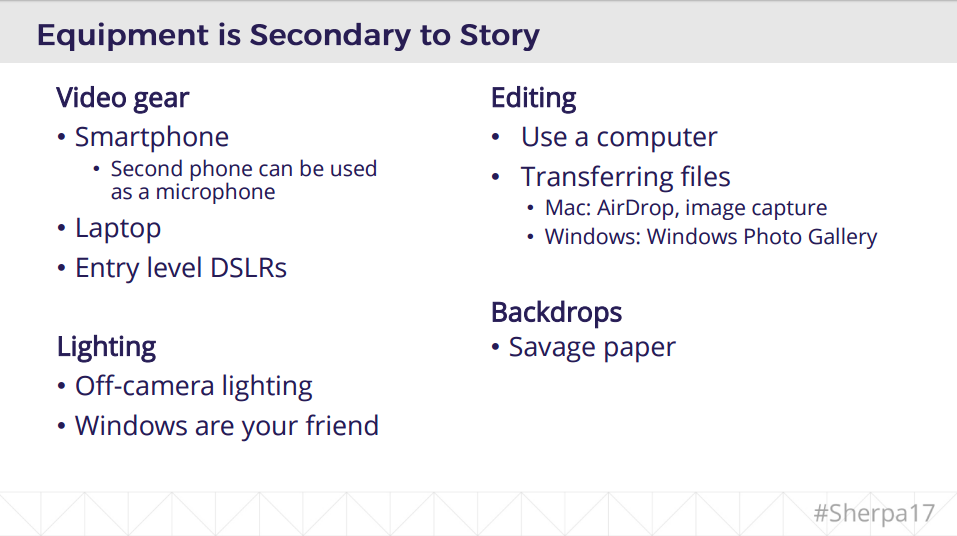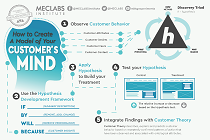
|
SUMMARY:
MarketingSherpa Summit is all about what you’re able to take home with you and apply to your marketing to see improvements with customers. Whether you attended Summit 2017 or not, these six takeaways from some of our inbound sessions can help you implement tactical changes on both a small and large scale. |
Inbound marketing is a conversation. Whether it’s content, SEO or social media, it’s all about communicating in your customers’ language. Understanding what they’re trying to tell you.
We talk about customer-first marketing a lot — and never more than at MarketingSherpa Summit. That’s when it becomes real for us, too. That’s when we get to see our year-long project put in front of our readers and attendees.

It starts off with planning of the show floor, and goes all the way through each session and piece of content, where we try to imagine every attendee’s journey and how they can maximize their time with us.
For all marketers, sometimes this means taking ourselves out of the equation and figuring out how we can bring customers together.
Tactic #1. Navigate Snapchat like a local
Our “Best Practices” sessions at MarketingSherpa Summit 2017 paired our brand-side speakers with industry thought leaders.
One of these sessions featured Frank Danna, Content Director, Softway and Stef Brower, Global Social Marketing, HP, discussing “Navigating the Complex (and Weird) Landscape of Snapchat: An inside look at HP’s Snapchat journey.”
Anyone who has used Snapchat knows that it’s a notoriously difficult nut for marketers to crack. Discoverability is a maze; growth is an uphill battle; and the casual and irreverent nature of the platform runs counter to the marketing strategies of many brands.

Danna and Brower walked the audience through HP’s Snapchat journey, from initial research, to securing buy-in, to testing their way into an authentic brand voice, to efficient content production, up to the recent evolution of HP’s Snapchat approach.
Targeting Generation Z, millennial students and the technologically savvy, HP saw Snapchat as a space where it could make an impact — precisely because most brands haven’t ventured into the platform yet.
The goal was to find topics that HP could own so it could become a voice of added value in users’ everyday lives. Snapchat is particularly ripe to do this because, unlike many other social media platforms where people can passively scroll through, Snapchat is 100% active.
“Ultimately, the goal is to be authentic. Use Snapchat like a real user. And do your best you can to engage with Snapchat users on their level,” Danna said.
Grow your audience with authentic, regular content
By partnering with people with a large following on the platform, HP was able to expose the brand to a new audience. However, Danna and Brower warned, it is very expensive, and it’s difficult to maintain the followers gained.
That’s when the team realized the importance of keeping an authentic brand voice — and only leveraging influencers when they fit into that — instead of trying to fit the brand into an influencers voice.
“You have to be careful that your content isn’t ultra-salesy or pushy. It needs to bring people value — not just value about your brand or the actual item you’re promoting or produce, but wisdom and experience you can apply to what you’re creating to actually add value for users,” Danna said.
Through testing, the team launched “What the Tech Wednesdays,” where the team and followers both knew they would have consistent content going up that would cover topics HP could be considered a leader in.
“Inconsistent and sporadic posting is an issue. You should post regularly — maybe once a week, once a month, twice a month — and make sure it happens on a consistent basis so people know when to expect it,” Danna said.
Work hard to make it look easy
Although it’s important to keep a casual, fun tone on Snapchat that feels spontaneous, the team would plan topics in advance, and they would even storyboard each of the two-minute long snaps that were going out.
Test snaps were reviewed each Tuesday before being sent out on Wednesday.
However, the most important aspect is to embrace the spontaneous nature of the platform — or what most marketers would refer to as limitations — and don’t overthink or overproduce it.
“To those of us who always have our buttons buttoned all the way up, on Snapchat, we need to unbutton one, maybe two buttons,” Danna said. “I’ve worked with a couple of different brands [that] actually produced everything outside of Snapchat and then just took a phone, held it up to a 4K monitor and recorded snaps off the monitor. It didn’t work. It looked completely fake, and the audience didn’t engage with it.”
Tactic #2. Continually A/B test to improve SEO strategy
Sparefoot is the largest online marketplace for finding self-storage — an industry that relies heavily on SEO.
Brett Billick, Chief Marketing Officer, SpareFoot, and his team developed a strategy to improve search rank through testing and optimizing for clickthrough rates.


After working several of these tests, the team saw the brand keyword ranking at 43.59%, with the only other competition coming close at 21.99%. Overall, traffic grew 42% by applying this A/B testing framework.
One of the key insights Billick and his team learned from this testing is that “what works in PPC does not always work in organic,” he said.
Tactic #3. Working in SAP’s content “chop shop”
Ginger Shimp, Senior Marketing Director, SAP, and her team have 19 industries to cater to and create content for.
“The challenge of content is you must be an expert — to people who are experts,” said Shimp.
In her Readers' Choice Award session, Shimp described how she and those working with her (across many teams) had to communicate complicated solutions to these complicated industries in which their customers were experts.
To serve them compelling, complex and correct content, she set up a “Tiger Team” of volunteers who had the time and drive to dedicate to producing it.
The first thing they realized was the need for “an online library of sorts,” she said, so they set up a digital content hub in order to speak directly to each of those customer sets.

Within each of these hubs, the team was focused on creating incremental, bite-sized, digitally-native assets and amplifying existing content through all digital and existing channels. Inside of each of these hubs, that content had to speak to chief information officers, chief technology officers, chief digital officers, chief marketing officers, among many other digital titles.
“We had the podcasts, the infographics, and we had everything that you could read and all kinds of videos. The next thing we had to ask was, did we have all of those for every level of buying? And, did we have it in every language?,” Shimp said.
Because different people digest content differently, the team decided to make it work for different learning styles — this is where the concept of a content “chop shop” came from.
The team made sure that content was in written, audio and visual formats so that customers could choose their preferred way to consume it. A piece of content was also always dropped into another piece of content that lead back to the original.
As for the ideas for the new content they were creating, the team mined Google Analytics and conducted customer surveys to determine what subjects were of greatest interest.
Tactic #4. Grow other channels using social media tactics
As the world’s fastest-growing watch brand and a bootstrapped start-up, MVMT had done most of its early growth on social media.
“If something happens to Facebook or Instagram, we want to make sure our business doesn’t die,” said Blake Pinsker, Marketing and Brand Director, MVMT.
Pinsker actually participated in the live optimization session at the previous year’s MarketingSherpa Summit, and he had his email critiqued by the audience out of a desire to focus the team’s effort on email growth.
They decided to work from their strength and take a social media approach to the email sphere. Starting out, the team decided to grow the list with a social media contest that required people to give their email address as a requirement for entry.
“Everyone was sent a coupon code for entering,” Pinsker said, adding that the contest collected 6,000 email addresses — 3% of participants were converted.
From there, the team focused on driving email channel growth through announcing a new product on social media.
“[We] told followers if they wanted first access to the collection, they could click through on the post and provide their email address,” Pinsker said.
The team collected 4,933 email addresses and saw a 55% open rate on the subsequent email about the product launch.
The important aspect of scaling as quickly as they did, Pinsker said, was to use email to deliver value. The MVMT demographic is younger and “doesn’t want to be sold to,” he said.
They diversified campaigns sent out into product focused, versus content focused, and currently, the “content-focused emails now sell just as well as the product-focused ones,” he said.
User-generated content versus staged photo shoots
Working between the two styles of email marketing led to testing over the most effective style of imagery to include in emails and on social.
“User-generated content vastly outperformed expensive model shoots,” Pinsker said.
By giving MVMT content a user-generated content feel, or at times using social media to turn customers from around the world into content creators, the team created an endless content arsenal.
As a result, the team saw an 88% decrease in cost per order and a 461% relative increase in engagements.
Tactic #5. Developing relationships in a digital community using video
One of the biggest challenges for your company when it comes to video marketing, according to Max Anderson, Video Producer, Nextiva, is the perceived lack of expertise, equipment and time.
Nextiva, a unified communication’s platform, including cloud VOIP, has an 18-person team in-house focused on customer and product marketing, web development and video production. Not exactly a full production house, and yet the video marketing they produce is exemplary.
Video can be used to effectively support customers during every stage of the funnel, he said.

During the discovery phase, Anderson said, you can introduce your product and service, even introducing customers to your staff by including them in the video.
“Fun videos perform much better higher in the funnel,” he said, explaining that the discovery phase should be primarily informational.
In the mid-to-late funnel, videos should focus on in-depth product and service dives and client testimonials, he said. This information comes just before the purchase point, so these videos should provide the information necessary for customers to take that next step.
In this stage, recurring characters (employees) resulted in an increased clickthrough rate for Nextiva, Anderson said, and testimonials and customer profile videos helped to increase third-party credibility.
When it comes to internal talent, he said, it’s as simple as asking around to see who is interested. From then on, just do everything you can to make sure they’re prepared and comfortable.
“On-camera talent is only as strong as the director,” he said.
Equipment is secondary to story
For all of these videos, he said, while an ideal setup is great, it’s not necessary. Make it look as professional as possible but remember that the most important aspect is providing valuable content.

“Equipment is secondary to story,” he said, giving the audience small but vital tips to follow, such as:
Really he said, when it comes to developing relationships with existing customers, it’s about finding good stories within your company.
“Start at the end,” he said. “What is the goal, [or] what should people be left feeling?”
Every story has three acts, he said, starting with a short introduction, moving onto the juicy content and ending with an enticing call-to-action.
While things may start off shaky, he said, it’s vital to learn from your mistakes and keep making videos. Upgrade equipment as needed but “don’t go crazy out of the gate. Start small and build up,” he said.
Since its inception, Nextiva’s YouTube page has grown to 1,398,333 views and 1,040 subscribers, Anderson said, which is the result of creating videos with the objective of genuinely helping people — not to “go viral.”
Tactic #6. Use content to make your customer more than just a number
There are few industries where it’s harder to differentiate yourself and gain customer trust than in health and physical fitness.
TigerFitness is an online nutritional retailer that sells workout supplements, alongside free workout and fitness content. Gaining trust was enough of an issue to differentiate the brand from its nutritional retailing competition, but it became a necessity for survival when competing against Amazon.
Lobliner and his team decided to focus on personality and impeccable service within their content to gain trust. He admitted it’s a hyper-personal approach, and that’s what differentiates the company in a competitive landscape.
With that personal approach, video content became the natural fit and a way to make customers feel like they were part of the TigerFitness team. They put together consistent content that is often based on customer feedback or questions.
This establishes the team, and Lobliner in particular, as a thought leader in the fitness sphere, and it builds trust for customers.
In his presentation, Lobliner gave the example of a video he made discussing TigerFitness.com removing a product due to liver toxicity issues.
“I don’t give a crap what you put in your body. I just want you to know what you’re putting in your body,” he said.
The message, coming from Lobliner himself, directly to the consumer in a video and not in some impersonal press release feels straightforward and trustworthy.
There is a spectrum between your typical brand marketing voice and the hyper-personal approach Lobliner takes, and it’s about understanding where your brand fits on it.
Wherever you are on the spectrum, every piece of content needs to back up and clearly articulate your value proposition, Lobliner said. Then build a customer-first content machine that efficiently delivers content of value to your customers.
“Walk the walk — show up and back it up,” Lobliner said, talking about how he and his employees never miss an opportunity to live up to the brand's value proposition. Most important in this is to “listen, respect and respond.”

One of the largest aspects of his social media strategy is to make it feel like a conversation — he and his team personally respond to many messages, and he makes sure to stay active in Twitter conversations.
The result of this hyper-personal approach for TigerFitness has been over 300,000 YouTube subscribers, 135,000 Instagram followers, 93,000 Facebook followers and 43,700 Twitter followers.
“Don’t be afraid to be YOU,” Lobliner said.
Sources
MarketingSherpa Summit – May 8-9, 2018 at the ARIA Las Vegas
MECLABS Institute (MarketingSherpa’s parent company)
Related Resources
Apply to speak at MarketingSherpa Summit 2018
To read about our award-winning Summit campaigns, download the MarketingSherpa Awards Book
Missed out on Summit? Get the presentation slides from each session.
Summit 2017 Featured speaker Catharine Hays was unable to attend, but you can see her featured speaker session in a webinar on May 3rd
Live from MarketingSherpa Summit 2017: Making your customer the hero of your campaign
Email Marketing: How MVMT Watches increased holiday revenue gains 262% with optimized content
Inbound Marketing: How TigerFitness has grown its fan base through high-value video content
Sherpa Summit 2017 Takeaways: The five best email tactics for customer-centric marketing
Get Better Business Results With a Skillfully Applied Customer-first Marketing Strategy

The customer-first approach of MarketingSherpa’s agency services can help you build the most effective strategy to serve customers and improve results, and then implement it across every customer touchpoint.
Get More Info >MECLABS AI

Get headlines, value prop, competitive analysis, and more.
Use the AI for FREE (for now) >Marketer Vs Machine

Marketer Vs Machine: We need to train the marketer to train the machine.
Watch Now >Live, Interactive Event

Join Flint McGlaughlin for Design Your Offer on May 22nd at 1 pm ET. You’ll learn proven strategies that drive real business results.
Get Your Scholarship >Free Marketing Course

Become a Marketer-Philosopher: Create and optimize high-converting webpages (with this free online marketing course)
See Course >Project and Ideas Pitch Template

A free template to help you win approval for your proposed projects and campaigns
Get the Template >Six Quick CTA checklists

These CTA checklists are specifically designed for your team — something practical to hold up against your CTAs to help the time-pressed marketer quickly consider the customer psychology of your “asks” and how you can improve them.
Get the Checklists >Infographic: How to Create a Model of Your Customer’s Mind

You need a repeatable methodology focused on building your organization’s customer wisdom throughout your campaigns and websites. This infographic can get you started.
Get the Infographic >Infographic: 21 Psychological Elements that Power Effective Web Design

To build an effective page from scratch, you need to begin with the psychology of your customer. This infographic can get you started.
Get the Infographic >Receive the latest case studies and data on email, lead gen, and social media along with MarketingSherpa updates and promotions.